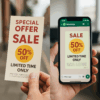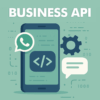Introduction of the messaging custom video for customers
Le imprese di maggior successo sono definite dalla loro capacità di comunicare. Oggi questo significa incontrare i consumatori dove si ritrovano – online, su più piattaforme. Le aziende , ad esempio, inviano regolarmente messaggi di vendita e marketing tramite SMS , e-mail e social media. Abbracciano sempre di più nuovi canali più ricchi come le OTT chat app is RCS .
Ma i consumatori non rispondono più alle comunicazioni di vendita isolatamente, ad esempio nell’ambito di un programma di fidelizzazione. Vogliono una comunicazione personalizzata e spesso bidirezionale e ricompenseranno felicemente le aziende che sono attente a questa esigenza, con ripetute abitudini e raccomandazioni.
È corretto affermare che la comunicazione è cresciuta oltre lo strumento di vendita per costituire la pietra angolare dell’esperienza del cliente. La lealtà verso un marchio o un’azienda non è più qualcosa su cui si può fare affidamento perché un consumatore ha ricevuto una qualche forma di incentivo, piuttosto deriva dall’esperienza del cliente – la somma di tutte le parti del percorso del cliente.
Allora perché così tante aziende continuano a lottare con la comunicazione con i clienti? Parte del problema risiede in un approccio mal strutturato che trasforma le funzioni aziendali in silos, in modo che le vendite e il marketing, il servizio clienti, il design ecc. Operino in modo isolato. Tuttavia, i clienti desiderano sperimentare un’organizzazione che offra un unico percorso continuo, dall’inchiesta iniziale fino all’assistenza post-vendita e oltre.
There are three main areas where simple improvements to your approach can pay dividends in the long run.
Go on the journey with your customers
le aziende devono esaminare “il viaggio” per capire dove può avvenire l’interazione. Questo inizia con alcune domande abbastanza basilari. Un viaggio tipico assomiglia a questo:
Make it relevant -
È importante sottolineare che la comunicazione deve essere personalizzata, pertinente e suddivisa in zone in base alle esigenze dei clienti come individui. Gli esempi potrebbero includere; a bordo di un nuovo cliente che ha recentemente aderito a un servizio con un caloroso benvenuto, un riconoscimento di ciò a cui si è iscritto e l’orientamento nei passaggi successivi o nei punti di abbandono – quando un contratto telefonico sta per scadere ad esempio, nel caso in cui il messaggio contenga opzioni che consentono di risparmiare denaro per il cliente passando a una tariffa diversa o offrendo loro il telefono più recente. Gartner chiama questo “aiuto su misura”. L’88% dei partecipanti al sondaggio tra i consumatori di Gartner ha dichiarato di non averlo ricevuto. Vale la pena notare che “aiuto” è un concetto di esperienza del cliente piuttosto che di vendita e marketing, tuttavia, secondo Gartner, l’utilizzo di un aiuto personalizzato sotto forma di messaggistica mobile aumenta del 20% i vantaggi commerciali (intento del marchio, acquisto, riacquisto e dimensioni del carrello aumentate). In altre parole, l’implementazione di un obiettivo di esperienza del cliente ha il potenziale per generare un vantaggio commerciale.
move
la messaggistica personalizzata crea evidentemente il coinvolgimento che i consumatori cercano, la messaggistica video personalizzata porta la rilevanza a un livello superiore. In sostanza, il video riunisce due cose – movimento e suono – che combinati trasmettono e semplificano i messaggi complessi dell’esperienza del cliente. Aggiungerlo al mix di esperienze porta l’impegno ben oltre ciò che può essere raggiunto con altri canali. L’analisi dei dati di Sinch ci dice che i messaggi video personalizzati vengono letti dal 98% dei consumatori che li ricevono (pari a SMS). Tuttavia, i consumatori conservano il 95% di un messaggio quando si tratta di un video, rispetto al 10% di conservazione su altri canali. Tornando all’esempio dell’onboarding, un’azienda potrebbe voler spiegare come attivare un account, come ottenere il massimo dal servizio e le opzioni per l’aggiornamento. È un sacco di testo e una comunicazione potenzialmente complessa. Un breve video personalizzato può semplificare enormemente il processo, rendendolo molto più semplice da realizzar



